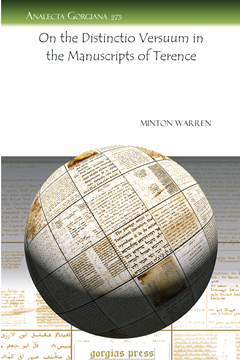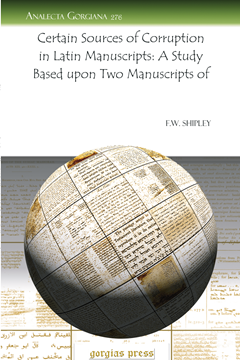The Madonnas of Luca Della Robbia
Series: Analecta Gorgiana 272
ISBN: 978-1-60724-501-8
Luca della Robbia was a Florentine sculptor who is currently thought to have lived from 1400-1482. In this article Alan Marquand suggests a chronology for the Madonnas sculpted by Luca della Robbia.
$37.00 (USD) $22.20 (USD)
On the Distinctio Versuum in the Manuscripts of Terence
Series: Analecta Gorgiana 273
ISBN: 978-1-60724-502-5
Minton Warren illuminates the process by which he and other editors navigate the very difficult task of editing the plays of Terrence from manuscript to edition.
$37.00 (USD) $22.20 (USD)
Studies in the Lives of Roman Empresses
Series: Analecta Gorgiana 274
ISBN: 978-1-60724-503-2
In this piece Mary Gilmore Williams uses literary and epigraphic evidence to reconstruct a portrait of two key women of the second century AD, Julia Domna, wife of Septimius Severus and mother of Cara-calla, and her niece Julia Mamaea.
$40.00 (USD) $24.00 (USD)
Greek Inscriptions from Corinth
Series: Analecta Gorgiana 275
ISBN: 978-1-60724-504-9
Powell gives a listing of surviving inscriptions from his excavations in Corinth with illustrations, text, and commentary that includes nine inscriptions that likely predate Julius Caesar's rebuilding of the city in 46 BC.
$40.00 (USD) $24.00 (USD)
A Study Based upon Two Manuscripts of
By F.W. Shipley
Series: Analecta Gorgiana 276
ISBN: 978-1-60724-505-6
In this article Shipley uses a parent and child manuscript of Livy to show how and why errors come into texts as they are copied and to suggest methods for recognizing such errors and correcting them.
$45.00 (USD) $27.00 (USD)
The Mycenaean Palace at Nippur
Series: Analecta Gorgiana 277
ISBN: 978-1-60724-506-3
This site report presents a Mycenean palace found at Nippur (a city in the heart of ancient Babylon) with a floor-plan and style similar to the palace at Tiryns.
$38.00 (USD) $22.80 (USD)
A Revised List of Roman Memorial and Triumphal Arches
Series: Analecta Gorgiana 278
ISBN: 978-1-60724-507-0
Arthur Frothingham, a father of the discipline of Art History, here lists and categorizes the form and development of the Roman triumphal arch.
$37.00 (USD) $22.20 (USD)
Oeniadae
Series: Analecta Gorgiana 279
ISBN: 978-1-60724-508-7
This site report for Oeniadae includes sections on the history and topography of this site, the remains of the theater, a temple, villa, a Greek bath, and the famous ship-sheds that housed the local fleet.
$56.00 (USD) $33.60 (USD)
The Pre-Periclean Propylon of the Acropolis at Athens
Series: Analecta Gorgiana 280
ISBN: 978-1-60724-509-4
In this paper Weller suggests the location, size, and form of the archaic building over which the Propyleia (the gateway building) now stands.
$40.00 (USD) $24.00 (USD)
An Attempt at Its Identification
Series: Analecta Gorgiana 281
ISBN: 978-1-60724-510-0
Dennison suggest that the 'Scipio type' Roman portrait bust, once thought to represent Scipio the elder, actually depicts priests of Isis, whose cult rose to prominence at the time these busts were carved.
$37.00 (USD) $22.20 (USD)









